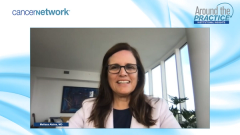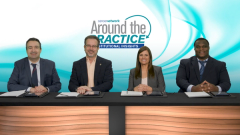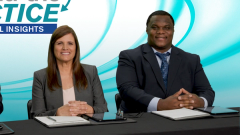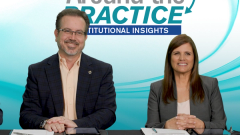
CAR T-Cell Therapy in Relapsed/Refractory Multiple Myeloma
Shared insight on the development of CAR T-cell therapies and their use in the later-line setting for patients with multiply relapsed multiple myeloma.
Episodes in this series

Transcript:
Melissa Alsina, MD: The main thing we still need to discuss that’s very important is CAR [chimeric antigen receptor] T-cell therapy. As everyone knows, we have 2 products that target BCMA and that have been approved recently for the treatment of patients with relapsed myeloma who have failed 4 lines of therapies. One product is ide-cel [idecabtagene vicleucel]; the other is cilta-cel [ciltacabtagene autoleucel]. They were approved based on the CARTITUDE-1 and KarMMA trials. Brandon, comment on those studies briefly and the results that led to the approval of these 2 drugs for relapsed myeloma.
Brandon Blue, MD: We were fortunate enough to be part of these groundbreaking trials. They showed that in populations of patients who’ve seen everything, some patients had 6 to 7 lines of therapy and were still able to get excellent overall response rates as well as progression-free survival [PFS]. Those things still need to be improved. The progression-free survival is around 16 months, which can be dramatic for patients who’ve had a tough time getting through treatment. But that can only be improved upon.
When it came down to cilta-cel [ciltacabtagene autoleucel] vs ide-cel [idecabtagene vicleucel], toxicity profiles are a little different. When you have a patient, you worry a little more about ICANS [immune effector cell-associated neurotoxicity syndrome]or the neurotoxicity that can be involved. Cytokine release syndrome is going to be standard in a lot of these therapies, but the neurotoxicity sometimes sets them apart. We see this a little more in the cilta-cel [ciltacabtagene autoleucel] product. Those are things to consider. I see patients trying to make a decision on which product is best for them. We want to try to mitigate that, especially for someone who has prior neurological issues; we don’t want to complicate those. Even though the risk is small, you don’t want to risk that for a patient who has relapsed disease. It’s good that we have options, especially in patients with advanced disease, but the response rates are relatively similar. They may be a little better, but the adverse effect profile is what separates the 2.
Melissa Alsina, MD: Rachid and Ken, what are the main differences when you think about ide-cel [idecabtagene vicleucel] and cilta-cel [ciltacabtagene autoleucel]? What differences come to mind immediately?
Rachid Baz, MD: It’s hard to compare the 2 studies. It’s a little like an apple-to-orange comparison. The patient populations were slightly different in the sense that there were, for example, more patients with extramedullary disease enrolled in the KarMMa study. The KarMMa study didn’t require a specific lymphocyte count. Prior to apheresis, the CARTITUDE study was a little more stringent. On the other hand, the CARTITUDE study showed PFS that’s a little more than double what you see with the KarMMa study. The median PFS of 20 or so months is very encouraging.
Melissa Alsina, MD: And complete remission rate.
Rachid Baz, MD: Complete remission rate is higher, and the response rate overall is higher. Because of that, we’re tempted to think that cilta-cel [ciltacabtagene autoleucel] is going to be a superior product. However, we have to be cautious because it comes with more CRS toxicity and higher-severity toxicity, including neurotoxicity, Parkinson [disease]–like symptoms. These are things we have to be cautious with, and a patient may not be suitable for both products. Sometimes a patient could be suitable for 1 of the 2 products. It’s a tremendous advance in therapy nonetheless, and it’s still very exciting.
Melissa Alsina, MD: We have to recognize that before CAR T or BiTEs [bispecific T-cell engagers], for this patient population we were measuring PFS in terms of…
Rachid Baz, MD: Three months.
Melissa Alsina, MD: Three months. Response rates were 30%, at best. Now we have cilta-cel [ciltacabtagene autoleucel], which can reduce response rates close to 100% and complete remission rates by 80%. I agree that we can’t compare ide-cel [idecabtagene vicleucel] head-to-head, but it looks like the response rates are a little lower. Progression-free survival is about a year, maybe a little less. In my experience—I want you guys to comment on this—I’m superexcited about this and I don’t get too discouraged about the short PFS. I understand that there’s still a lot of work to do and a lot of room for improvement, but these agents have [a great impact] on the quality of life of these patients.
I’ve taken patients to CAR T who can’t walk; they’re in a bed. Obviously, that patient wasn’t been eligible for a trial. Then a month later, because their response is very quick, the patient is walking and traveling to the other side of the world. The response rate could last 11 months, but many patients have told me that these 11 months are the best time in their lives. It’s incredible. Because of that, even though we’re not curing patients with this—we’re far from curing patients with these therapies—the way they’re administered, the results are superencouraging. There are many trials looking at these products early in the course of the disease. Hopefully, this will have a much bigger impact on the population with relapsed/refractory disease.
Ken Shain, MD: I was going to make the same point. We’ve been very lucky with ide-cel [idecabtagene vicleucel] because we’ve had a lot of patients, thankfully. So we’ve had a lot of slots for these patients to have this. We’ve had a great experience with it off study: 75% to 80% of patients we put on commercial ide-cel [idecabtagene vicleucel] wouldn’t be on a trial. These are patients who wouldn’t make trial criteria, but they’re benefiting greatly from it despite their status. We’ve seen those patients—no disease, come in every 3 months, no therapy. Their lives are amended. It’s amazing when you watch someone not on therapy. We need to think about how we get people off therapy.
With cilta-cel [ciltacabtagene autoleucel], we don’t know yet because we haven’t seen what happens outside clinical studies. There aren’t that many slots available, so there aren’t those comparisons. We don’t how it’s going to affect disease in the regular community. We say ide-cel [idecabtagene vicleucel] has PFS of X, and cilta-cel [ciltacabtagene autoleucel] has a PSF here. We did a study where we use the same construct as ide-cel [idecabtagene vicleucel], changed the T cells a little, and they look almost like cilta-cel [ciltacabtagene autoleucel]. But we don’t know the answers about how things are going to work.
We’re at the beginning of this—CAR T cells, bispecifics, whatever T-cell–engaging aspect we’re talking about. We’re at the beginning. This is all T cells. In the other arm of the immune system, we’re trying to learn how to engage natural killer cells and myeloid cells…. We’re at the beginning of this. How do we move these things forward? How do we mix those with the drugs we have? Immunotherapy against myeloma, added to the drugs we have—antimyeloma or plasma cell biology drugs—is something we’re still working on. The next generation of other T cells and non–T-cell immune vector populations is going to be really exciting.
Melissa Alsina, MD: You hinted that we don’t have all these products, so they’re not available to our patients. When ide-cel [idecabtagene vicleucel] was approved over a year ago, we had very limited slots for our patients and a long waiting list. We lost quite a few patients on that waiting list. This gets back to the bispecifics. That shouldn’t happen now because I have teclistamab that I can give to a patient, like Rachid’s patient, who can’t wait 2 months to get CAR T cells. Because ide-cel [idecabtagene vicleucel] was approved before cilta-cel [ciltacabtagene autoleucel], the manufacturing issues have been improved, and there’s more availability of these agents. We’re in a better position to offer this to our patients in a timely fashion. With cilta-cel [ciltacabtagene autoleucel], we’re still not there. We don’t have as much experience. Hopefully, in the next year, that will change, we’ll be able to treat more patients with this and gain more real-world experience with this product as well.
Transcript edited for clarity.
Newsletter
Stay up to date on recent advances in the multidisciplinary approach to cancer.






















































































